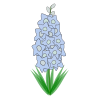Larkspur is a charming and vibrant flowering plant belonging to the Delphinium genus, known for its tall spikes of colourful blossoms. It thrives in temperate climates and is often found in cottage gardens, meadows, and wildflower plantings. Larkspur blooms in early to mid-summer, displaying a range of hues including deep blue, violet, pink, and white.
Each individual flower is uniquely shaped, with petal-like sepals forming a spur at the back—hence the name "larkspur," as the shape resembles a lark’s claw. These showy spikes can grow between 1 to 6 feet tall, depending on the variety.
Larkspur holds symbolic meaning in floral traditions, often associated with lightness, an open heart, and positive energy. However, despite its beauty, all parts of the plant are toxic if ingested, particularly to livestock, so it should be handled with care.
This flower not only adds height and texture to garden borders but also attracts pollinators like bees and butterflies, making it both an aesthetic and ecologically valuable addition to any landscape.
How To Grow
- Choose the Right Time to Plant
Cool-season annual: Larkspur prefers cooler temperatures to germinate and grow.
Best time to sow:
Fall (mild climates) – Sow directly in the garden for spring blooms.
Early spring (cold climates) – Sow as soon as the soil can be worked.
- Start from Seed
Pre-chill seeds: Larkspur seeds need cold to germinate. Place seeds in the fridge (in a paper towel or bag) for 1–2 weeks before sowing.
Sow outdoors: Plant seeds directly in the ground, 1/8 inch deep.
Spacing: Leave about 6–12 inches between plants.
-
Provide the Right Growing Conditions
Sunlight: Full sun (at least 6 hours per day).
Soil: Well-drained, slightly alkaline soil.
Watering: Keep soil moist but not soggy. Once established, larkspur is somewhat drought tolerant.
-
Care and Maintenance
Thinning: Once seedlings are 2–3 inches tall, thin them to prevent overcrowding.
Support: Tall varieties may need staking to prevent flopping.
Deadheading: Remove spent flowers to encourage more blooms.
Pests/Disease: Generally low-maintenance, but watch for slugs and powdery mildew in humid conditions.
Safety Note
Toxicity: All parts of larkspur are poisonous to humans and animals. Wear gloves when handling and keep away from pets and livestock.
How/When To Harvesting
- Harvesting for Fresh Flowers
Best time: Early morning, when temperatures are cool.
Stage: Cut stems when 1/3 to 1/2 of the flowers on a spike are open.
How to cut:
Use clean, sharp scissors or pruners.
Cut the stem at an angle just above a leaf node.
Conditioning: Immediately place stems in a bucket of clean, cool water. Let them hydrate for a few hours in a cool, dark place before arranging.
- Harvesting for Drying
Ideal stage: When most flowers are open but not yet dropping.
Method:
Cut stems as above.
Strip lower leaves.
Hang upside down in a dry, dark, well-ventilated area for 2–3 weeks.
Dried larkspur retains color well and is popular in everlasting arrangements.
- Harvesting Seeds
Wait until: Seed pods turn brown and dry on the plant.
Collecting:
Snip off pods and place in a paper bag.
Allow to dry further indoors for a few days.
Break open pods and collect the small, black seeds.
Storage: Keep seeds in a cool, dry place. Refrigeration helps preserve viability.


